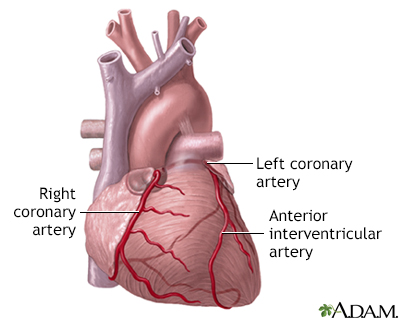Pregnancy SmartSiteTM
Heart disease, Coronary heart disease, Coronary artery disease; Arteriosclerotic heart disease; CHD; CAD DefinitionCoronary heart disease is a narrowing of the blood vessels that supply blood and oxygen to the heart. Coronary heart disease (CHD) is also called coronary artery disease. CausesCHD is the leading cause of death in the United States for men and women. CHD is caused by the buildup of plaque in the arteries to your heart. This may also be called hardening of the arteries or atherosclerosis.
A risk factor for heart disease is something that increases your chance of getting it. You cannot change some risk factors for heart disease, but you can change others. SymptomsIn some cases, symptoms may be very noticeable. But, you can have the disease and not have any symptoms. This is more often true in the early stages of CHD. Chest pain or discomfort (angina) is the most common symptom. You feel this pain when the heart is not getting enough blood or oxygen. The pain may feel different from person to person.
Some people have symptoms other than chest pain, such as:
Exams and TestsYour health care provider will examine you. You will often need one or more tests before getting a diagnosis. Tests to evaluate for CHD may include:
TreatmentYou may be asked to take one or more medicines to treat blood pressure, diabetes, or high cholesterol levels. Follow your provider's directions closely to help prevent CHD from getting worse. Goals for treating these conditions in people who have CHD:
Treatment depends on your symptoms and how severe the disease is. You should know about:
Never stop taking your medicines without first talking to your provider. Stopping heart medicines suddenly can make your angina worse or cause a heart attack. You may be referred to a cardiac rehabilitation program to help improve your heart's fitness. Procedures and surgeries used to treat CHD include:
Outlook (Prognosis)Everyone recovers differently. Some people can stay healthy by changing their diet, stopping smoking, and taking their medicines as prescribed. Others may need medical procedures such as angioplasty or surgery. In general, early detection of CHD generally leads to a better outcome. When to Contact a Medical ProfessionalIf you have any risk factors for CHD, talk to your provider about prevention and possible treatment steps. Call your provider, call the local emergency number (such as 911), or go to the emergency room right away if you have:
PreventionTake these steps to help prevent heart disease.
Even if you already have heart disease, taking these steps will help protect your heart and prevent further damage. ReferencesArnett DK, Blumenthal RS, Albert MA, et al. 2019 ACC/AHA Guideline on the primary prevention of cardiovascular disease: a report of the American College of Cardiology/American Heart Association Task Force on Clinical Practice Guidelines. [published correction appears in Circulation. 2019;140(11):e649-e650] [published correction appears in Circulation. 2020;141(4):e60] [published correction appears in Circulation. 2020;141(16):e774]. Circulation. 2019 2019;140(11):e596-e646. PMID: 30879355 pubmed.ncbi.nlm.nih.gov/30879355/. Boden WE. Angina pectoris and stable ischemic heart disease. In: Goldman L, Cooney KA, eds. Goldman-Cecil Medicine. 27th ed. Philadelphia, PA: Elsevier; 2024:chap 56. Marks AR. Cardiac and circulatory function. In: Goldman L, Cooney KA, eds. Goldman-Cecil Medicine. 27th ed. Philadelphia, PA: Elsevier; 2024:chap 41. Morrow DA, de Lemos J. Stable ischemic heart disease. In: Libby P, Bonow RO, Mann DL, Tomaselli GF, Bhatt DL, Solomon SD, eds. Braunwald's Heart Disease: A Textbook of Cardiovascular Medicine. 12th ed. Philadelphia, PA: Elsevier; 2022:chap 40. Virani SS, Newby LK, Arnold SV, et al. 2023 AHA/ACC/ACCP/ASPC/NLA/PCNA Guideline for the management of patients with chronic coronary disease: A report of the American Heart Association/American College of Cardiology joint committee on clinical practice guidelines. Circulation. 2023;148:e9–e119. Whelton PK, Carey RM, Aronow WS, et al. 2017 ACC/AHA/AAPA/ABC/ACPM/AGS/APhA/ASH/ASPC/NMA/PCNA guideline for the prevention, detection, evaluation, and management of high blood pressure in adults: a report of the American College of Cardiology/American Heart Association Task Force on Clinical Practice Guidelines. Hypertension. 2018;72(3):e33. PMID: 29133354 pubmed.ncbi.nlm.nih.gov/29133354/. | ||
| ||
Review Date: 3/31/2024 Reviewed By: Larry A. Weinrauch MD, Assistant Professor of Medicine, Harvard Medical School, Cardiovascular Disease and Clinical Outcomes Research, Watertown, MA. Review provided by VeriMed Healthcare Network. Also reviewed by David C. Dugdale, MD, Medical Director, Brenda Conaway, Editorial Director, and the A.D.A.M. Editorial team. View References The information provided herein should not be used during any medical emergency or for the diagnosis or treatment of any medical condition. A licensed medical professional should be consulted for diagnosis and treatment of any and all medical conditions. Links to other sites are provided for information only -- they do not constitute endorsements of those other sites. No warranty of any kind, either expressed or implied, is made as to the accuracy, reliability, timeliness, or correctness of any translations made by a third-party service of the information provided herein into any other language. © 1997- A.D.A.M., a business unit of Ebix, Inc. Any duplication or distribution of the information contained herein is strictly prohibited. | ||


 Heart - section th...
Heart - section th... Heart - front view
Heart - front view Anterior heart art...
Anterior heart art... Posterior heart ar...
Posterior heart ar... Acute MI
Acute MI Cholesterol produc...
Cholesterol produc... Atherosclerosis
Atherosclerosis
